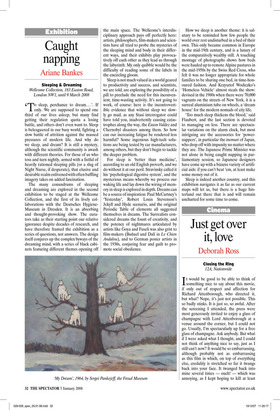Caught napping
Ariane Bankes
Sleeping & Dreaming Wellcome Collection, 183 Euston Road, London NW1, until 9 March 2008
‘To sleep, perchance to dream... ’. If only. We are supposed to spend one third of our lives asleep, but many find getting their regulation quota a losing battle, and others don’t even want to. Sleep is beleaguered in our busy world, fighting a slow battle of attrition against the massed pressures of modern life. And why do we sleep, and dream? It is still a mystery, although the scientific community is awash with different theories. For those of us who toss and turn nightly, armed with a fistful of heavily rationed sleeping pills (or a slug of Night Nurse, if desperate), that elusive and desirable realm enlivened with often baffling imagery takes on added fascination.
The many conundrums of sleeping and dreaming are explored in the second exhibition to be staged at the Wellcome Collection, and the first of its lively collaborations with the Deutsches HygieneMuseum in Dresden. It is an absorbing and thought-provoking show. The curators take as their starting point our relative ignorance despite decades of research, and have therefore framed the exhibition as a series of questions, not answers. The design itself conjures up the complex byways of the dreaming mind, with a series of black cabinets featuring different themes opening off the main space. The Wellcome’s interdisciplinary approach pays off perfectly here: artists, philosophers, film-makers and scientists have all tried to probe the mysteries of the sleeping mind and body in their different ways, and their exhibits play provocatively off each other as they lead us through the labyrinth. My only quibble would be the difficulty of reading some of the labels in the encircling gloom.
Sleep is not much valued in a world geared to productivity and success, and scientists, we are told, are exploring the possibility of a pill to preclude the need for this inconvenient, time-wasting activity. It’s not going to work, of course: here is the incontrovertible evidence that without sleep we slowly go mad, as any Stasi interrogator could have told you, inadvertently causing catastrophes along the way, the Exxon Valdez and Chernobyl disasters among them. So how can our increasing fatigue be rendered less harmful? Some ingenious high-tech solutions are being tested by car manufacturers, among others, but they don’t begin to tackle the deeper problem.
For sleep is ‘better than medicine’, according to an old English proverb, and we do without it at our peril. Stravinsky called it his ‘psychological digestive system’, and the mysterious means whereby we process our waking life and lay down the wiring of memory in sleep is explored in depth. Dreams can be a source of inspiration: Paul McCartney’s ‘Yesterday’, Robert Louis Stevenson’s Jekyll and Hyde scenario, and the original Periodic Table of elements all suggested themselves in dreams. The Surrealists considered dreams the fount of creativity, and the potency of nightmares articulated by artists like Goya and Fuseli was also grist to film-makers (Buiiuel and Dalí in Le Chien Andalou), and to German poster artists in the 1930s, conjuring fear and guilt to promote social obedience. How we sleep is another theme: it is salutary to be reminded how few people the world over rest undisturbed in a bed of their own. This only became common in Europe in the mid-19th century, and is a luxury of the comparatively wealthy still. A touching montage of photographs shows how beds were hauled up to remote Alpine pastures in the mid-1950s by the Swiss Red Cross, who felt it was no longer appropriate for whole families to be sharing one bed, in time-honoured fashion. And Krzysztof Wodiczko’s ‘Homeless Vehicle’ almost steals the show: devised in the 1980s when there were 70,000 vagrants on the streets of New York, it is a surreal aluminium tube on wheels, a ‘dream house’ for the modern nomads of city life.
‘Too much sleep thickens the blood,’ said Flaubert, and the last section is devoted to managing on less. There are spectacular variations on the alarm clock, but most intriguing are the accessories for ‘powernappers’, in particular the inemuri of Japan, who drop off with impunity no matter where they are. The Japanese Prime Minister was not alone in being caught napping in parliamentary session, so Japanese designers have come up with a bizarre variety of artificial aids: if you can’t beat ’em, at least make some money out of it.
Sleep is indeed another country, and this exhibition navigates it as far as our current maps will let us, but there is a huge hinterland out there that is and will remain uncharted for some time to come.


















































 Previous page
Previous page